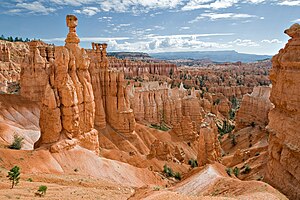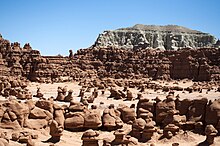Hoodoo (geology)
Hoodoos typically consist of relatively soft rock topped by harder, less easily eroded stone that protects each column from the elements.For example, hoodoos in Bryce Canyon National Park were considered petrified remains of ancient beings who had been sanctioned for misbehavior.Hoodoo formations are commonly found on the Colorado Plateau and in the Badland regions of the northern Great Plains (both in North America).While hoodoos are scattered throughout these areas, nowhere in the world are they so abundant as in the northern section of Bryce Canyon National Park, located in the U.S. state of Utah.[10] Đavolja Varoš (Devil's Town) hoodoos in Serbia feature about 200 formations described as earth pyramids or towers by local inhabitants.[13] With time, erosion of the soft layer causes the cap to be undercut, eventually falling off, and the remaining cone is then quickly eroded.Dolomite, being fortified by the mineral magnesium, dissolves at a much slower rate, and consequently protects the weaker limestone underneath it.







Kasha-Katuwe Tent Rocks National MonumentHoodooBryce Canyon National Parkerosionsedimentary rockMineralsSouthern PaiuteNative AmericansSierra de Órganos National ParkMexicopinnacles (or spires)totem poleColorado PlateauBadlandGreat PlainsGoblin Valley State ParkSan Rafael SwellNew MexicoChiricahua National MonumentSombrereteSierra de Organos National ParkÇavuşinCappadociaTurkeyreversenew liraArmeniaKhndzoreskPontisAlpes-de-Haute-ProvenceFranceDemoiselles Coiffées de PontisMioceneAwa Sand PillarsTokushima PrefectureĐavolja VarošNew Seven Wonders of NatureDrumhellerAlbertaCretaceous PeriodSerbiaandesitemudstonesandstonelimestonebasaltweathering processesBryce Canyonfrost wedgingpotholeBalancing rockBisti/De-Na-Zin WildernessCity of Rocks State ParkEarth pyramids of South TyrolGeology of the Bryce Canyon areaGöreme National ParkList of rock formationsMushroom rockPrincess of HopeTsingy de Bemaraha Strict Nature ReserveTulin (geology)YardangNational Park ServiceBibcode